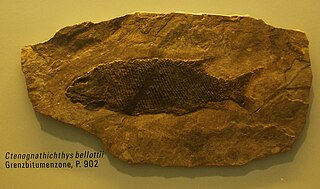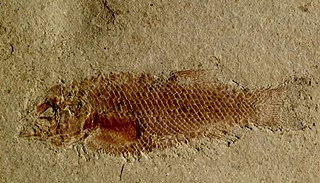
Whiteia is an extinct genus of prehistoric coelacanth fish which lived during the Triassic period. It is named after Errol White.

Atopocephala is an extinct genus of prehistoric freshwater ray-finned fish that lived during the Middle Triassic epoch. It contains a single species, A. watsoni from the Karoo Supergroup of South Africa. A potential indeterminate species was known from the Timezgadiouine Formation of Morocco, but is now considered an indeterminate actinopterygian.

Australosomus is an extinct genus of prehistoric ray-finned fish that lived during the Early Triassic epoch in what is now Greenland, Kenya, Tanzania, Madagascar, South Africa and Canada.

Brookvalia is an extinct genus of prehistoric freshwater ray-finned fish that lived during the Middle Triassic epoch.

Dictyopyge is an extinct genus of prehistoric freshwater ray-finned fish that inhabited eastern North America during the early part of the Late Triassic. Two species are recognized, both from the early Carnian-aged Doswell Formation in what is now Virginia, United States:
Helichthys is an extinct genus of prehistoric bony fish that lived during the Early Triassic epoch in what is now South Africa.
Sakamenichthys is an extinct genus of prehistoric bony fish that lived during the Early Triassic epoch in what is now Madagascar. Fossils were recovered from beds of the Middle Sakamena Formation of the Beroroha basin in the southern part of the island.
Agecephalichthys is an extinct genus of prehistoric freshwater "palaeonisciform" ray-finned fish that lived during the Anisian age. It contains a single species, A. granulatus from the Hawkesbury Sandstone in what is now New South Wales, Australia.
Inichthys is an extinct genus of prehistoric marine bony fish that lived during the Lopingian epoch. Fossils were recovered in the Kuznetsk Basin, European Russia.
Aphelolepis is an extinct genus of prehistoric ginglymodian bony fish. It contains one species, A. delpi, that lived during the Ladinian age of the Middle Triassic epoch in what is now Franconia, Germany. It is generally considered a semionotiform.
Crenilepis is an extinct genus of prehistoric marine ray-finned fish that lived in the seas of present-day Europe during the Middle Triassic epoch. It contains a single species, C. sandbergi from the Anisian of Germany, Spain, and the Besano Formation of the Swiss-Italian border.
Dorsolepis is an extinct genus of prehistoric bony fish that lived during the early Anisian age in what is now France (Alsace) and Germany (Baden-Württemberg). Fossils were found in the Grès à Voltzia in Alsace and in the Buntsandstein in Baden-Württemberg.

Besania is an extinct genus of prehistoric marine ray-finned fish that lived during the Anisian and Ladinian ages of the Middle Triassic epoch in what is now southern/southeastern Switzerland and northern Italy. Fossils were recovered from the Besano Formation of Monte San Giorgio area and the Prosanto Formation of canton Graubünden, Switzerland.

Ctenognathichthys is an extinct genus of prehistoric marine ray-finned fish that lived during the Middle Triassic epoch of Europe, in the former Tethys Ocean.

Acentrophorus is an extinct genus of prehistoric freshwater and marine ray-finned fish from the Roadian to the Wuchiapingian of England, Germany (Kupferschiefer), Italy and Russia. There may also be a Triassic occurrence in Australia.

Bobasatrania is an extinct genus of prehistoric marine ray-finned fish that survived the Permian-Triassic extinction event. Fossils of Bobasatrania were found in beds of Changhsingian to Ladinian age. It was most speciose during the Early Triassic.
Corunegenys is an extinct genus of prehistoric freshwater ray-finned fish that lived during the Late Triassic epoch near what is now Bowral in New South Wales, Australia. It contains a single species, C. bowralensis. Some studies suggest that it may be related to Semionotus capensis.
Urosthenes is an extinct genus of prehistoric bony fish that lived during the Lopingian to Middle Triassic epochs in what is now New South Wales, Australia.
Korutichthys is an extinct genus of prehistoric marine bony fish that lived during the Lopingian epoch in what is now Krasnoyarsk Krai, Russia. It was first referred to the family Amblypteridae, a view that was later questioned.
Turseodus is an extinct genus of ray-finned fish found in Late Triassic freshwater sediments of the United States. Two species have been described, T. acutus from the Lockatong Formation of Pennsylvania, and T. dolorensis from the Chinle Formation of Colorado.













